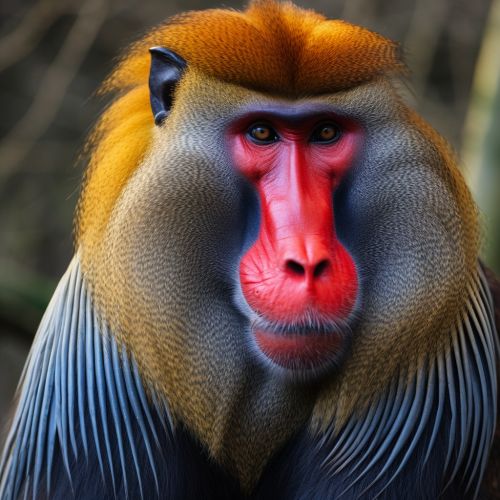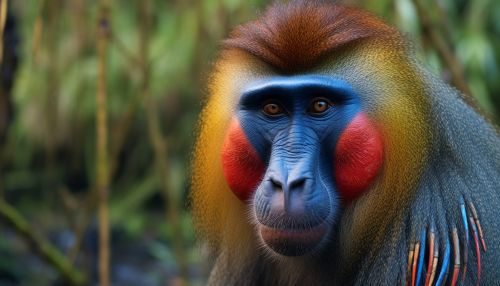Mandrill
Taxonomy and Evolution
The Mandrill (Mandrillus sphinx) is a primate of the Old World monkey (Cercopithecidae) family. It is one of two species assigned to the genus Mandrillus, along with the Drill. Both the Mandrill and the Drill were once classified as baboons in the genus Papio, but they now have their own genus, Mandrillus. Although they look similar to baboons, they have significant differences such as the coloration and the absence of a long tail.


Physical Characteristics
Mandrills are noted for their striking coloring. Their long, dog-like snouts are colored with blue and red patches and their rumps are multi-colored. They also have extremely long canine teeth that can be used for self-defense. Males are significantly larger than females, weighing up to 60 pounds, while females weigh about half that.
Behavior and Ecology
Mandrills are social creatures and live in large groups, primarily led by a dominant male. These groups, also known as hordes, can contain up to 800 individuals. The dominant male, with his bright colors, leads the group and the females follow, with their offspring. Mandrills are semi-terrestrial monkeys and spend much of their time on the ground, foraging for food. They are omnivorous and their diet consists of fruits, roots, and animals such as insects, reptiles, and amphibians.
Reproduction
Mandrills reproduce seasonally, and the mating season usually coincides with the wet season. The dominant male mates with multiple females and guards them from other males. Females give birth to a single offspring after a gestation period of about 7 months. The young are cared for by their mothers and other females in the group.
Distribution and Habitat
Mandrills are found in the tropical rainforests of southern Cameroon, Gabon, Equatorial Guinea, and Congo. Their habitat is bounded by the Sanaga River to the north and the Ogooué and White Rivers to the east. They are adapted to live in these dense forests and are not found in open savanna or other habitats.
Conservation Status
The mandrill is listed as vulnerable by the IUCN. The main threats to mandrills are habitat loss due to deforestation and hunting for bushmeat. Efforts are being made to conserve their populations and protect their habitat.
Cultural Significance
In many cultures, the mandrill is seen as a symbol of strength and courage. Its colorful face and rump have made it a popular subject in art and literature. In popular culture, the mandrill is perhaps most famous for the character Rafiki in the Disney movie The Lion King.
